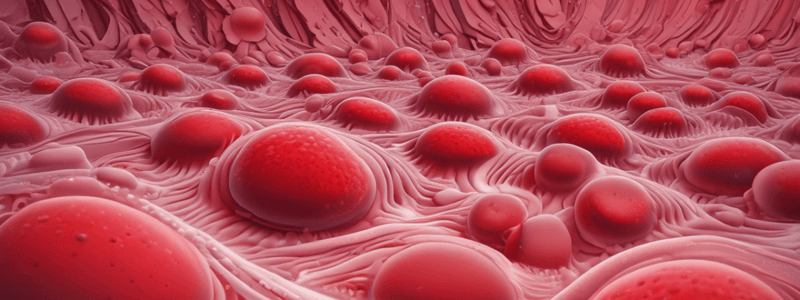Podcast
Questions and Answers
What happens to the walls of blood vessels when we get a cut?
What happens to the walls of blood vessels when we get a cut?
- They become narrower
- They develop holes (correct)
- They release chemicals to attract platelets
- They become stronger
What is the main function of platelets in the coagulation process?
What is the main function of platelets in the coagulation process?
- To produce clotting factors
- To build fibers around the cut
- To form a plug to stop bleeding (correct)
- To attract blood cells to the cut
What is the term for the process of liquid blood becoming a solid clot to stop bleeding?
What is the term for the process of liquid blood becoming a solid clot to stop bleeding?
- Clotting
- Hemostasis
- Coagulation (correct)
- Blood Cirulation
What is the role of clotting factors in the coagulation process?
What is the role of clotting factors in the coagulation process?
What is the first step in the coagulation process?
What is the first step in the coagulation process?
What is the purpose of the clot formed during coagulation?
What is the purpose of the clot formed during coagulation?
How do platelets respond to a damaged blood vessel?
How do platelets respond to a damaged blood vessel?
What signals do damaged blood vessels send to alert platelets?
What signals do damaged blood vessels send to alert platelets?
What happens to the platelet plug after it is formed?
What happens to the platelet plug after it is formed?
What is the overall goal of the coagulation process?
What is the overall goal of the coagulation process?
Flashcards are hidden until you start studying
Study Notes
Blood Vessels and Cuts
- When we get a cut, it causes holes in the walls of our blood vessels, which can lead to unhealthy blood loss.
Coagulation Process
- Coagulation is the process of liquid blood becoming a solid clot to stop bleeding.
- It involves the formation of clots that work like natural Band-Aids to stop bleeding from inside the blood vessels.
- Three substances found in blood work together to make clots: platelets, clotting factors, and blood cells.
Platelets
- Platelets are tiny sticky cells found in blood.
- They spring into action when a blood vessel is damaged, responding to chemical signals sent through the blood.
- Platelets rush to the site of the cut and bleeding, sticking together and to the sides of the cut to plug the hole and stop the bleeding.
- They form a plug, which is the first step of the coagulation process.
Clotting Factors
- Clotting factors are proteins that help the platelets stick together and build fibers around the platelet plug.
- They can be thought of as spiders building a sticky web, making the plug stronger and keeping it in place.
Blood Cells
- Red blood cells and white blood cells can get caught in the web of platelets and fibers, becoming part of the clot.
- These extra cells help strengthen the clot.
Clot Function and Dissolution
- A clot stops blood from leaking out of a broken blood vessel while a cut heals.
- After a cut heals, the body breaks down the clot.
Studying That Suits You
Use AI to generate personalized quizzes and flashcards to suit your learning preferences.




